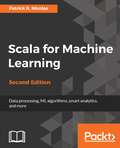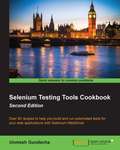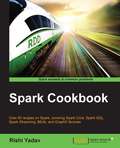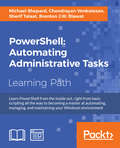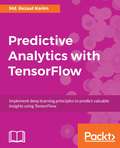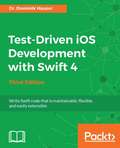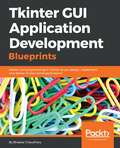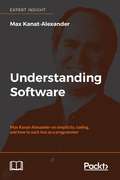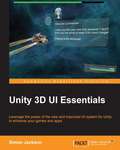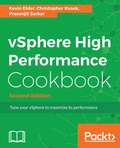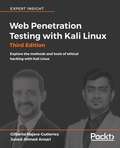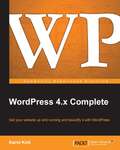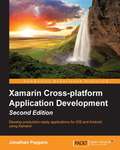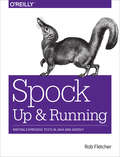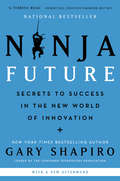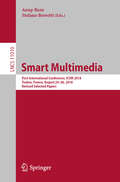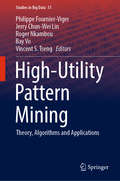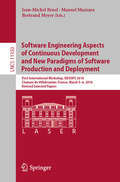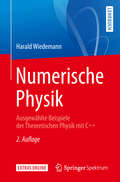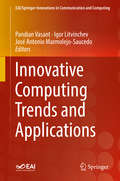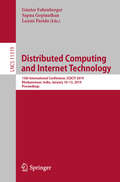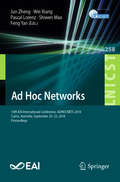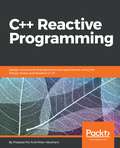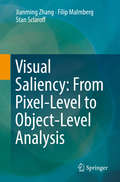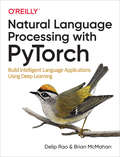- Table View
- List View
Scala for Machine Learning Second Edition
by Patrick R. NicolasLeverage Scala and Machine Learning to study and construct systems that can learn from dataAbout This Book* Explore a broad variety of data processing, machine learning, and genetic algorithms through diagrams, mathematical formulation, and updated source code in Scala* Take your expertise in Scala programming to the next level by creating and customizing AI applications* Experiment with different techniques and evaluate their benefits and limitations using real-world applications in a tutorial styleWho This Book Is ForIf you're a data scientist or a data analyst with a fundamental knowledge of Scala who wants to learn and implement various Machine learning techniques, this book is for you. All you need is a good understanding of the Scala programming language, a basic knowledge of statistics, a keen interest in Big Data processing, and this book!What You Will Learn* Build dynamic workflows for scientific computing* Leverage open source libraries to extract patterns from time series* Write your own classification, clustering, or evolutionary algorithm* Perform relative performance tuning and evaluation of Spark* Master probabilistic models for sequential data* Experiment with advanced techniques such as regularization and kernelization* Dive into neural networks and some deep learning architecture* Apply some basic multiarm-bandit algorithms* Solve big data problems with Scala parallel collections, Akka actors, and Apache Spark clusters* Apply key learning strategies to a technical analysis of financial marketsIn DetailThe discovery of information through data clustering and classification is becoming a key differentiator for competitive organizations. Machine learning applications are everywhere, from self-driving cars, engineering design, logistics, manufacturing, and trading strategies, to detection of genetic anomalies.The book is your one stop guide that introduces you to the functional capabilities of the Scala programming language that are critical to the creation of machine learning algorithms such as dependency injection and implicits. You start by learning data preprocessing and filtering techniques. Following this, you'll move on to unsupervised learning techniques such as clustering and dimension reduction, followed by probabilistic graphical models such as Naive Bayes, hidden Markov models and Monte Carlo inference. Further, it covers the discriminative algorithms such as linear, logistic regression with regularization, kernelization, support vector machines, neural networks, and deep learning. You'll move on to evolutionary computing, multibandit algorithms, and reinforcement learning.Finally, the book includes a comprehensive overview of parallel computing in Scala and Akka followed by a description of Apache Spark and its ML library. With updated codes based on the latest version of Scala and comprehensive examples, this book will ensure that you have more than just a solid fundamental knowledge in machine learning with Scala.Style and approachThis book is designed as a tutorial with hands-on exercises using technical analysis of financial markets and corporate data. The approach of each chapter is such that it allows you to understand key concepts easily.
Selenium Testing Tools Cookbook Second Edition
by Unmesh GundechaThis is a cookbook packed with code examples and step-by-step instructions to ease your learning curve. This book is intended for software quality assurance/testing professionals, software project managers, or software developers with prior experience in using Selenium and Java for testing web-based applications. This book also provides examples for C#, Python, and Ruby users.
Spark Cookbook
by Rishi YadavBy introducing in-memory persistent storage, Apache Spark eliminates the need to store intermediate data in filesystems, thereby increasing processing speed by up to 100 times. This book will focus on how to analyze large and complex sets of data. Starting with installing and configuring Apache Spark with various cluster managers, you will cover setting up development environments. You will then cover various recipes to perform interactive queries using Spark SQL and real-time streaming with various sources such as Twitter Stream and Apache Kafka. You will then focus on machine learning, including supervised learning, unsupervised learning, and recommendation engine algorithms. After mastering graph processing using GraphX, you will cover various recipes for cluster optimization and troubleshooting.
PowerShell: Automating Administrative Tasks
by Michael Shepard Chendrayan Venkatesan Sherif Talaat Brenton J. W. BlawatLearn PowerShell from the inside out, right from basic scripting all the way to becoming a master at automating, managing, and maintaining your Windows environment About This Book Use proven best practices to optimize code and automate redundant tasks Get to grips with PowerShell's advanced functions and effectively administer your system Create a variety of PowerShell scripts to automate your environment Who This Book Is For If you are a system administrator who wants to become an expert in automating and managing your Windows environment, then this course is for you. Some basic understanding of PowerShell would be helpful. What You Will Learn Discover PowerShell commands and cmdlets and understand PowerShell formatting Solve common problems using basic file input/output functions Use .NET classes in Windows PowerShell and C# and manage Exchange Online Use PowerShell in C# to manage Exchange Online and work with .NET classes in PowerShell Automate LYNC clients, consuming client-side object models to administrate SharePoint Online Optimize code through the use of functions, switches, and looping structures Manage files, folders, and registries through the use of PowerShell Discover best practices to manage Microsoft systems In Detail Are you tired of managing Windows administrative tasks manually and are looking to automate the entire process? If yes, then this is the right course for you. This learning path starts your PowerShell journey and will help you automate the administration of the Windows operating system and applications that run on Windows. It will get you up and running with PowerShell, taking you from the basics of installation to writing scripts and performing web server automation. You will explore the PowerShell environment and discover how to use cmdlets, functions, and scripts to automate Windows systems. The next installment of the course focuses on gaining concrete knowledge of Windows PowerShell scripting to perform professional-level scripting. The techniques here are packed with PowerShell scripts and sample C# code to automate tasks. You will use .NET classes in PowerShell and C# to manage Exchange Online. In the final section, you will delve into real-world examples to learn how to simplify the management of your Windows environment. You will get to grips with PowerShell's advanced functions and how to most effectively administer your system. This Learning Path combines some of the best that Packt has to offer in one complete, curated package. It includes content from the following Packt products: Getting Started with PowerShell by Michael Shepard Windows PowerShell for .Net Developers Second Edition by Chendrayan Venkatesan and Sherif Talaat Mastering Windows PowerShell Scripting by Brenton J.W. Blawat Style and approach This is a step-by-step course to help you effectively administer and maintain your development environment with PowerShell.
Predictive Analytics with TensorFlow
by Rezaul KarimAccomplish the power of data in your business by building advanced predictive modelling applications with Tensorflow. About This Book A quick guide to gain hands-on experience with deep learning in different domains such as digit/image classification, and texts Build your own smart, predictive models with TensorFlow using easy-to-follow approach mentioned in the book Understand deep learning and predictive analytics along with its challenges and best practices Who This Book Is For This book is intended for anyone who wants to build predictive models with the power of TensorFlow from scratch. If you want to build your own extensive applications which work, and can predict smart decisions in the future then this book is what you need! What You Will Learn Get a solid and theoretical understanding of linear algebra, statistics, and probability for predictive modeling Develop predictive models using classification, regression, and clustering algorithms Develop predictive models for NLP Learn how to use reinforcement learning for predictive analytics Factorization Machines for advanced recommendation systems Get a hands-on understanding of deep learning architectures for advanced predictive analytics Learn how to use deep Neural Networks for predictive analytics See how to use recurrent Neural Networks for predictive analytics Convolutional Neural Networks for emotion recognition, image classification, and sentiment analysis In Detail Predictive analytics discovers hidden patterns from structured and unstructured data for automated decision-making in business intelligence. This book will help you build, tune, and deploy predictive models with TensorFlow in three main sections. The first section covers linear algebra, statistics, and probability theory for predictive modeling. The second section covers developing predictive models via supervised (classification and regression) and unsupervised (clustering) algorithms. It then explains how to develop predictive models for NLP and covers reinforcement learning algorithms. Lastly, this section covers developing a factorization machines-based recommendation system. The third section covers deep learning architectures for advanced predictive analytics, including deep neural networks and recurrent neural networks for high-dimensional and sequence data. Finally, convolutional neural networks are used for predictive modeling for emotion recognition, image classification, and sentiment analysis. Style and approach TensorFlow, a popular library for machine learning, embraces the innovation and community-engagement of open source, but has the support, guidance, and stability of a large corporation.
Test-Driven iOS Development with Swift 4
by Dominik HauserUse test-driven approach to develop highly-functional iOS apps with Swift 4 and Xcode 9 About This Book A practical guide to writing effective, organized, and clean code that works well Learn test-driven principles to help you build better-designed apps with fewer bugs A comprehensive overview of the techniques available for TDD in Swift Who This Book Is For To get the most out of this book, you will need some prior experience with Swift application development. You may have already heard about Test-Driven Development (TDD) but you don't need any prior experience of applying it to Swift applications. What You Will Learn Implement TDD in Swift application development Find bugs before you enter code using the TDD approach Use TDD to build models, view controllers, and views Test network code with asynchronous tests and stubs Write code that is a joy to read and maintain Develop functional tests to ensure the app works as planned In Detail Test-driven development (TDD) is a proven way to find software bugs early. Writing tests before you code improves the structure and maintainability of your apps. Using TDD, in combination with Swift 4's improved syntax, means there is no longer any excuse for writing bad code. This book will help you understand the process of TDD and how to apply it to your apps written in Swift. Through practical, real-world examples, you'll learn how to implement TDD in context. You will begin with an overview of the TDD workflow and then delve into unit-testing concepts and code cycles. You will also plan and structure your test-driven iOS app, and write tests to drive the development of view controllers and helper classes. Next, you'll learn how to write tests for network code and explore how the test-driven approach—in combination with stubs—helps you write network code even before the backend component is finished. Finally, the book will guide you through the next steps to becoming a testing expert by discussing integration tests, Behavior Driven Development (BDD), open source testing frameworks, and UI Tests (introduced in Xcode 9). Style and approach Using a step-by-step approach, you will develop an entire iOS app using TDD. During the course of the book, you will explore different strategies for writing tests for models, View Controllers, and networking code.
Tkinter GUI Application Development Blueprints
by Bhaskar ChaudharyGeometry Management, Event Handling, and more Key Features A Practical, guide to learn the application of Python and GUI programming with tkinter Create multiple cross-platform real-world projects by integrating host of third party libraries and tools Learn to build beautiful and highly interactive user interfaces, targeting multiple devices. Book Description Tkinter is the built-in GUI package that comes with standard Python distributions. It is a cross-platform package, which means you build once and deploy everywhere. It is simple to use and intuitive in nature, making it suitable for programmers and non-programmers alike. This book will help you master the art of GUI programming. It delivers the bigger picture of GUI programming by building real-world, productive, and fun applications such as a text editor, drum machine, game of chess, audio player, drawing application, piano tutor, chat application, screen saver, port scanner, and much more. In every project, you will build on the skills acquired in the previous project and gain more expertise. You will learn to write multithreaded programs, network programs, database-driven programs, asyncio based programming and more. You will also get to know the modern best practices involved in writing GUI apps. With its rich source of sample code, you can build upon the knowledge gained with this book and use it in your own projects in the discipline of your choice. What you will learn -A Practical, guide to help you learn the application of Python and GUI programming with Tkinter - Create multiple, cross-platform, real-world projects by integrating a host of third-party libraries and tools - Learn to build beautiful and highly interactive user interfaces, targeting multiple devices. Who this book is for This book is for a beginner to intermediate-level Pythonists who want to build modern, cross-platform GUI applications with the amazingly powerful Tkinter. Prior knowledge of Tkinter is required.
Understanding Software
by Max Kanat-AlexanderSoftware legend Max Kanat-Alexander shows you how to succeed as a developer by embracing simplicity, with forty-three essays that will help you really understand the software you work with. About This Book Read and enjoy the superlative writing and insights of the legendary Max Kanat-Alexander Learn and reflect with Max on how to bring simplicity to your software design principles Discover the secrets of rockstar programmers and how to also just suck less as a programmer Who This Book Is For Understanding Software is for every programmer, or anyone who works with programmers. If life is feeling more complex than it should be, and you need to touch base with some clear thinking again, this book is for you. If you need some inspiration and a reminder of how to approach your work as a programmer by embracing some simplicity in your work again, this book is for you. If you're one of Max's followers already, this book is a collection of Max's thoughts selected and curated for you to enjoy and reflect on. If you're new to Max's work, and ready to connect with the power of simplicity again, this book is for you! What You Will Learn See how to bring simplicity and success to your programming world Clues to complexity - and how to build excellent software Simplicity and software design Principles for programmers The secrets of rockstar programmers Max's views and interpretation of the Software industry Why Programmers suck and how to suck less as a programmer Software design in two sentences What is a bug? Go deep into debugging In Detail In Understanding Software, Max Kanat-Alexander, Technical Lead for Code Health at Google, shows you how to bring simplicity back to computer programming. Max explains to you why programmers suck, and how to suck less as a programmer. There's just too much complex stuff in the world. Complex stuff can't be used, and it breaks too easily. Complexity is stupid. Simplicity is smart. Understanding Software covers many areas of programming, from how to write simple code to profound insights into programming, and then how to suck less at what you do! You'll discover the problems with software complexity, the root of its causes, and how to use simplicity to create great software. You'll examine debugging like you've never done before, and how to get a handle on being happy while working in teams. Max brings a selection of carefully crafted essays, thoughts, and advice about working and succeeding in the software industry, from his legendary blog Code Simplicity. Max has crafted forty-three essays which have the power to help you avoid complexity and embrace simplicity, so you can be a happier and more successful developer. Max's technical knowledge, insight, and kindness, has earned him code guru status, and his ideas will inspire you and help refresh your approach to the challenges of being a developer. Style and approach Understanding Software is a new selection of carefully chosen and crafted essays from Max Kanat-Alexander's legendary blog call Code Simplicity. Max's writing and thoughts are great to sit and read cover to cover, or if you prefer you can drop in and see what you discover new every single time!
Unity 3D UI Essentials
by Simon JacksonIf you have a good understanding of Unity's core functionality and a decent grasp of C# scripting in Unity (although not essential if you are just using the Editor with the new UI), you'll be well placed to take advantage of the new UI feature set.
vSphere High Performance Cookbook - Second Edition
by Kevin ElderOver 80 recipes to help you improve vSphere 6.5's performance and solve problems before they ariseAbout This Book* The practical recipes provide cost-effective and high performance for any application running in a virtual machine* Contains best practices and troubleshooting techniques to resolve vSphere 6.5 performance issues * Get a comprehensive coverage of performance issues and solutions including vCenter Server design and virtual machine and application tuningWho This Book Is ForIf you are a system administrator and are planning to deploy vSphere 6.5 in your organization and want to maximize its performance, then this book is for you. Prior knowledge of the vSphere 6.5 concepts is essential.What You Will Learn* Understand the VMM Scheduler, cache aware CPU Scheduler, NUMA aware CPU Scheduler, and more during the CPU Performance Design phase* Get to know the virtual memory reclamation technique, host ballooning monitoring, and swapping activity* Choose the right platform while designing your vCenter Server, redundant vCenter design, and vCenter SSO and its deployment* Learn how to use various performance simulation tools* Design VCSA Server Certificates to minimize security threats* Use health check tools for storage and boost vSphere 6.5's performance with VAAI and VASAIn DetailvSphere is a mission-critical piece of software for many businesses. It is a complex tool, and incorrect design and deployment can create performance related issues that can negatively affect the business. This book is focused on solving these problems as well as providing best practices and performance-enhancing techniques. This edition is fully updated to include all the new features in version 6.5 as well as the latest tools and techniques to keep vSphere performing at its best.This book starts with interesting recipes, such as the interaction of vSphere 6.5 components with physical layers such as CPU, memory, and networking. Then we focus on DRS, resource control design, and vSphere cluster design. Next, you'll learn about storage performance design and how it works with VMware vSphere 6.5. Moving on, you will learn about the two types of vCenter installation and the benefits of each. Lastly, the book covers performance tools that help you get the most out of your vSphere installation.By the end of this book, you will be able to identify, diagnose, and troubleshoot operational faults and critical performance issues in vSphere 6.5.Style and approachThis cookbook is written in a practical, helpful style with numerous recipes focusing on answering and providing solutions to common and not-so-common performance issues and problems.
Web Penetration Testing with Kali Linux - Third Edition: Explore The Methods And Tools Of Ethical Hacking With Kali Linux, 3rd Edition
by Gilberto Nájera-GutiérrezWeb Penetration Testing with Kali Linux - Third Edition shows you how to set up a lab, helps you understand the nature and mechanics of attacking websites, and explains classical attacks in great depth. This edition is heavily updated for the latest Kali Linux changes and the most recent attacks. Kali Linux shines when it comes to client-side attacks and fuzzing in particular. From the start of the book, you'll be given a thorough grounding in the concepts of hacking and penetration testing, and you'll see the tools used in Kali Linux that relate to web application hacking. You'll gain a deep understanding of classicalSQL, command-injection flaws, and the many ways to exploit these flaws. Web penetration testing also needs a general overview of client-side attacks, which is rounded out by a long discussion of scripting and input validation flaws. There is also an important chapter on cryptographic implementation flaws, where we discuss the most recent problems with cryptographic layers in the networking stack. The importance of these attacks cannot be overstated, and defending against them is relevant to most internet users and, of course, penetration testers. At the end of the book, you'll use an automated technique called fuzzing to identify flaws in a web application. Finally, you'll gain an understanding of web application vulnerabilities and the ways they can be exploited using the tools in Kali Linux.
WordPress 4.x Complete
by Karol KrolIf you want a website at low cost, without the need to hire a team of developers and designers, then this book is for you. It will help you take your first steps into the world of website creation.
Xamarin Cross-platform Application Development Second Edition
by Jonathan PeppersIf you are a developer with experience in C# and are just getting into mobile development, this is the book for you. If you have experience with desktop applications or the Web, this book will give you a head start on cross-platform development.
Spock: Writing Expressive Tests in Java and Groovy
by Rob FletcherMost developers would agree that writing automated tests is a good idea, but writing good, well-structured tests is still an elusive skill for many. For Java and Groovy developers, however, there’s good news. This practical guide shows you how to write concise and highly readable tests with Spock, the most innovative testing and specification framework for the JVM since JUnit.Author Rob Fletcher takes you from Spock basics to advanced topics, using fully worked integration examples. Through the course of this book, you’ll build a simple web application—Squawker—that allows users to post short messages. You’ll discover how much easier it is to write automated tests with Spock’s straightforward and expressive language.Start by learning how to write simple unit testsUnderstand the lifecycle of Spock specifications and feature methodsDive into interaction testing, using Spock’s intuitive syntax for dealing with mocks and stubsLearn about parameterized tests—writing feature methods that run for multiple sets of dataMove into advanced topics, such as writing idiomatic Spock code and driving parameterized tests with file or database inputLearn how everything works together in a standalone, fully-worked, test-driven development example
Ninja Future: Secrets to Success in the New World of Innovation
by Gary ShapiroNinja Future is an essential read for businesses and individuals striving to remain competitive in a rapidly evolving world: Gary Shapiro, the president and CEO of the Consumer Technology Association, casts his eye toward the future, charting how the innovative technologies of today will transform not only the way business is done but society itselfDuring his more than three decades at the head of the Consumer Technology Association, Gary Shapiro has witnessed, and been a part of, one of the most extraordinary periods of technological change in human history. Today’s world is almost unrecognizable from that of just a decade or two before: in just a few short years, the internet has already transformed how we access information, purchase goods, get from place to place, and do our jobs. And even greater changes are on the horizon. In Ninja Future, Shapiro explains the evolving technological landscape, breakthroughs underway now and those we can only envision. New innovations such as self-driving vehicles, blockchain, 5G, the Internet of Things, and countless others will forever change the economy as we know it. Shapiro uses case studies to identify companies and countries addressing today’s challenges particularly well—and relates lessons from those that have stumbled. Drawing on the insights he has gleaned as a martial arts black belt, he shows how businesses can move to succeed in today’s turbulent environment by adopting the mindset of “ninjas”—adapting to technological change to capitalize on opportunities at lightning speed.
Smart Multimedia: First International Conference, ICSM 2018, Toulon, France, August 24–26, 2018, Revised Selected Papers (Lecture Notes in Computer Science #11010)
by Anup Basu Stefano BerrettiThis book constitutes the proceedings of the First International Conference on Smart Multimedia, ICSM 2018, which was held in Toulon, France, in August 2018. The 39 papers presented were selected from about 100 submissions and are grouped in sections on social, affective and cognition analysis, person-centered smart multimedia: serving people with disabilities to the general population, haptic and robots for smart multimedia applications, MR, 3D, underwater image processing, smart signal processing meets smart sensing, visual behavior analysis: methods and applications, video analysis, learning, low-level vision, miscellaneous.
High-Utility Pattern Mining: Theory, Algorithms and Applications (Studies in Big Data #51)
by Philippe Fournier-Viger Jerry Chun-Wei Lin Roger Nkambou Bay Vo Vincent S. TsengThis book presents an overview of techniques for discovering high-utility patterns (patterns with a high importance) in data. It introduces the main types of high-utility patterns, as well as the theory and core algorithms for high-utility pattern mining, and describes recent advances, applications, open-source software, and research opportunities. It also discusses several types of discrete data, including customer transaction data and sequential data.The book consists of twelve chapters, seven of which are surveys presenting the main subfields of high-utility pattern mining, including itemset mining, sequential pattern mining, big data pattern mining, metaheuristic-based approaches, privacy-preserving pattern mining, and pattern visualization. The remaining five chapters describe key techniques and applications, such as discovering concise representations and regular patterns.
Software Engineering Aspects of Continuous Development and New Paradigms of Software Production and Deployment: First International Workshop, DEVOPS 2018, Chateau de Villebrumier, France, March 5-6, 2018, Revised Selected Papers (Lecture Notes in Computer Science #11350)
by Jean-Michel Bruel Manuel Mazzara Bertrand MeyerThis book constitutes revised selected papers from the First International Workshop on Software Engineering Aspects of Continuous Development and New Paradigms of Software Production and Deployment, DEVOPS 2018, hled at the hateau de Villebrumier, France, in March 2018. The 17 papers presented in this volume were carefully reviewed and selected from 23 submissions. They cover a wide range of problems arising from Devops and related approaches, current tools, rapid development-deployment processes, effects on team performance, analytics, trustworthiness, microservices and related topics.
Numerische Physik: Ausgewählte Beispiele der Theoretischen Physik mit C++ (Springer-Lehrbuch)
by Harald WiedemannDieses Lehrbuch stellt die Numerische Physik anhand einer Vielzahl von Beispielen aus den Bereichen Mechanik, Elektrodynamik, Optik, Statistischer Physik und Quantenmechanik dar. Der Leser lernt hier nicht nur die wichtigsten numerischen Techniken in der Programmiersprache C++ kennen, sondern erhält auch neue Einblicke in die Physik, die konventionelle Zugänge nicht bieten. Das Werk schließt damit eine Lücke zwischen den Standardlehrbüchern der Theoretischen Physik und denen der reinen Programmierung.Zu jedem der physikalischen Themen gibt es eine kurze Wiederholung des theoretischen Hintergrunds und anschließend werden ausgewählte Beispiele im Detail ausgearbeitet. Übungen am Ende des Kapitels bieten weitere Gelegenheit die Anwendungen des Gelernten zu vertiefen.Das Buch richtet sich vornehmlich an Physikstudierende höherer Semester, die bereits über eine Basis in Theoretischer Physik verfügen und auch Grundkenntnisse in der Programmierung in C++ mitbringen.Auf der Produktseite zum Buch auf springer.com finden sich alle Quelltexte zu den Programmen im Buchtext zum Download. Im Anhang erhalten Sie eine Zusammenstellung und Erläuterung frei verfügbarer Software, die sowohl dem Windows-Anwender als auch dem Linux-Freund alle Werkzeuge an die Hand gibt, die er zur Bearbeitung anspruchsvoller physikalischer Fragestellungen benötigt - von Compilern über numerische Bibliotheken bis hin zu Visualisierungstools.
Innovative Computing Trends and Applications (EAI/Springer Innovations in Communication and Computing)
by Pandian Vasant Igor Litvinchev José Antonio Marmolejo-SaucedoThis book provides a survey on research, development, and trends in innovative computing in communications engineering and computer science. It features selected and expanded papers from the EAI International Conference on Computer Science and Engineering 2018 (COMPSE 2018), with contributions by top global researchers and practitioners in the field. The content is of relevance to computer science graduates, researchers and academicians in computer science and engineering. The authors discuss new technologies in computer science and engineering that have reduced the dimension of data coverage worldwide, reducing the gaps and coverage of domains globally. They discuss how these advances have also contributed to strength in prediction, analysis, and decision in the areas such as Technology, Management, Social Computing, Green Computing, and Telecom. Contributions show how nurturing the research in technology and computing is essential to finding the right pattern in the ocean of data.Focuses on research areas of innovative computing and its application in engineering and technology;Includes contributions from researchers in computing and engineering from around the world;Features selected and expanded papers from EAI International Conference on Computer Science and Engineering 2018 (COMPSE 2018).
Distributed Computing and Internet Technology: 15th International Conference, ICDCIT 2019, Bhubaneswar, India, January 10–13, 2019, Proceedings (Lecture Notes in Computer Science #11319)
by Günter Fahrnberger Sapna Gopinathan Laxmi ParidaThis book constitutes the proceedings of the 15th International Conference on Distributed Computing and Internet Technology, ICDCIT 2019, held in Bhubaneswar, India, in January 2019.The 18 full papers and 14 short papers presented together with 5 invited papers were carefully reviewed and selected from 115 submissions. The papers present research in three areas: distributed computing, Internet technologies, and societal applications.
Ad Hoc Networks: 10th EAI International Conference, ADHOCNETS 2018, Cairns, Australia, September 20-23, 2018, Proceedings (Lecture Notes of the Institute for Computer Sciences, Social Informatics and Telecommunications Engineering #258)
by Jun Zheng Wei Xiang Pascal Lorenz Shiwen Mao Feng YanThis book constitutes the refereed proceedings of the 10th International Conference on Ad Hoc Networks, ADHOCNETS 2018, held in Cairns, Australia, in September 2018. The 27 full papers were selected from 50 submissions and cover a variety of network paradigms including mobile ad hoc networks, sensor networks, vehicular networks, underwater networks, airborne networks, underground networks, personal area networks, device-to-device (D2D) communications in 5G cellular networks, and home networks. The papers present a wide range of applications in civilian, commercial, and military areas.
C++ Reactive Programming: Design concurrent and asynchronous applications using the RxCpp library and Modern C++17
by Peter Abraham Praseed PaiLearn how to implement the reactive programming paradigm with C++ and build asynchronous and concurrent applicationsKey Features Efficiently exploit concurrency and parallelism in your programs Use the Functional Reactive programming model to structure programs Understand reactive GUI programming to make your own applications using QtBook DescriptionReactive programming is an effective way to build highly responsive applications with an easy-to-maintain code base. This book covers the essential functional reactive concepts that will help you build highly concurrent, event-driven, and asynchronous applications in a simpler and less error-prone way.C++ Reactive Programming begins with a discussion on how event processing was undertaken by different programming systems earlier. After a brisk introduction to modern C++ (C++17), you’ll be taken through language-level concurrency and the lock-free programming model to set the stage for our foray into the Functional Programming model. Following this, you’ll be introduced to RxCpp and its programming model. You’ll be able to gain deep insights into the RxCpp library, which facilitates reactive programming. You’ll learn how to deal with reactive programming using Qt/C++ (for the desktop) and C++ microservices for the Web.By the end of the book, you will be well versed with advanced reactive programming concepts in modern C++ (C++17).What you will learnUnderstand language-level concurrency in C++Explore advanced C++ programming for the FRPUncover the RxCpp library and its programming modelMix the FP and OOP constructs in C++ 17 to write well-structured programsMaster reactive microservices in C++Create custom operators for RxCppLearn advanced stream processing and error handlingWho this book is forIf you’re a C++ developer interested in using reactive programming to build asynchronous and concurrent applications, you’ll find this book extremely useful. This book doesn’t assume any previous knowledge of reactive programming.
Visual Saliency: From Pixel-Level to Object-Level Analysis
by Jianming Zhang Filip Malmberg Stan SclaroffThis book will provide an introduction to recent advances in theory, algorithms and application of Boolean map distance for image processing. Applications include modeling what humans find salient or prominent in an image, and then using this for guiding smart image cropping, selective image filtering, image segmentation, image matting, etc. In this book, the authors present methods for both traditional and emerging saliency computation tasks, ranging from classical low-level tasks like pixel-level saliency detection to object-level tasks such as subitizing and salient object detection. For low-level tasks, the authors focus on pixel-level image processing approaches based on efficient distance transform. For object-level tasks, the authors propose data-driven methods using deep convolutional neural networks. The book includes both empirical and theoretical studies, together with implementation details of the proposed methods. Below are the key features for different types of readers.
Natural Language Processing with PyTorch: Build Intelligent Language Applications Using Deep Learning
by Delip Rao Brian McMahanNatural Language Processing (NLP) provides boundless opportunities for solving problems in artificial intelligence, making products such as Amazon Alexa and Google Translate possible. If you’re a developer or data scientist new to NLP and deep learning, this practical guide shows you how to apply these methods using PyTorch, a Python-based deep learning library.Authors Delip Rao and Brian McMahon provide you with a solid grounding in NLP and deep learning algorithms and demonstrate how to use PyTorch to build applications involving rich representations of text specific to the problems you face. Each chapter includes several code examples and illustrations.Explore computational graphs and the supervised learning paradigmMaster the basics of the PyTorch optimized tensor manipulation libraryGet an overview of traditional NLP concepts and methodsLearn the basic ideas involved in building neural networksUse embeddings to represent words, sentences, documents, and other featuresExplore sequence prediction and generate sequence-to-sequence modelsLearn design patterns for building production NLP systems
